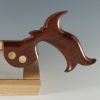00000_geGM0QP0Sizz_0CI0t2_600x450.jpg Picked this up last weekend. Other than a couple dents from careless storage & some needed cleaning/maintenance, it appears in excellent condition with limited actual usage. Not sure on age - also included was an original Craftsman Accessory kit with Molding Head & shaping guard, Rotary Surface Planer, Sabre Saw & Fence attachment. And.. Radial Arm Saw Techniques by Roger W. Cliffe , with some magazine clippings on wood joinery from a 1972 issue of Popular Mechanics.
Next will be a new table based on Mr Sawdust plans...




 Reply With Quote
Reply With Quote





